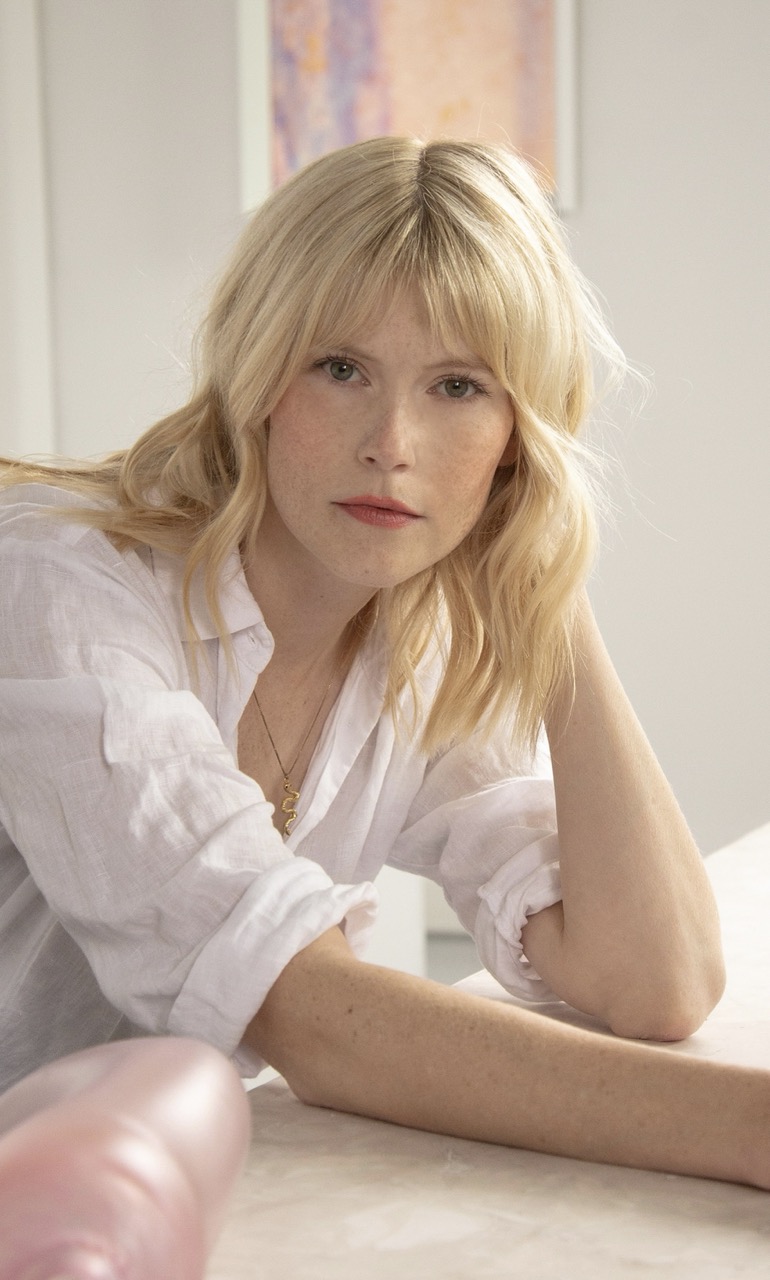
Bridging Art and Science: A Conversation with Dana Fiona Armour
Olina Olseth, AMT Program Assistant, had a talk with Dana-Fiona Armour (@danafionaarmour)– artist and instructor at Parsons Paris in Core Studio Spatial. Born in 1988 in Willich, Germany, Dana now lives and works in Paris. She graduated from École Nationale Supérieure des Beaux-Arts in 2019 and has since made many achievements. Currently, she is an artist resident at the Poush Collective and her work has been exhibited in numerous galleries across New York, France, Saudi Arabia, Germany, Sweden, and Italy. In 2024, she won the Sigg Art Prize with her piece “Alvinella Ophis”, a 3D animated video installation exploring the intersection of biotechnology, artificial intelligence and contemporary art. In this conversation, Olina Olseth delves into Dana’s practice, her fascination with the intersection of art and science, and a sneak peek into the student exhibition at Parsons Paris.
OO: You describe yourself as an “artist-researcher”. How does research shape your artistic practice?
DFA: I’ve always been interested in biology, natural science, and medicine. Before going to art school, I was really hesitant between becoming a veterinarian or an artist. So it was really like, I didn’t know what to do, or what to study. Even after choosing Beaux-Arts in Paris, that curiosity about living organisms never left me. My early work involved working with organic matter in a very literal sense. Then, by chance, I met a surgeon from Necker Hospital who offered me my first residency there. That experience set me on this path, leading to other residencies, including at a biotech company called Cellectis, where I did a show at Collection Lambert in 2023. Currently, I’m in residence at the Museum of Natural History in Paris, where I’m collaborating with a group of biologists.
OO: The way you merge science and art I find intriguing. You take scientific concepts, which might feel inaccessible to many, and translate them into visually engaging pieces.
DFA: Yes, that’s what I’m aiming to do. The scientific world can be intimidating—research papers are dense, and most people don’t engage with them. But I think understanding how life functions is crucial to respecting it. I see myself as a translator between different species. Before every show, I gather a ton of knowledge and then translate it into an accessible visual language, aiming to make complex ideas captivating.
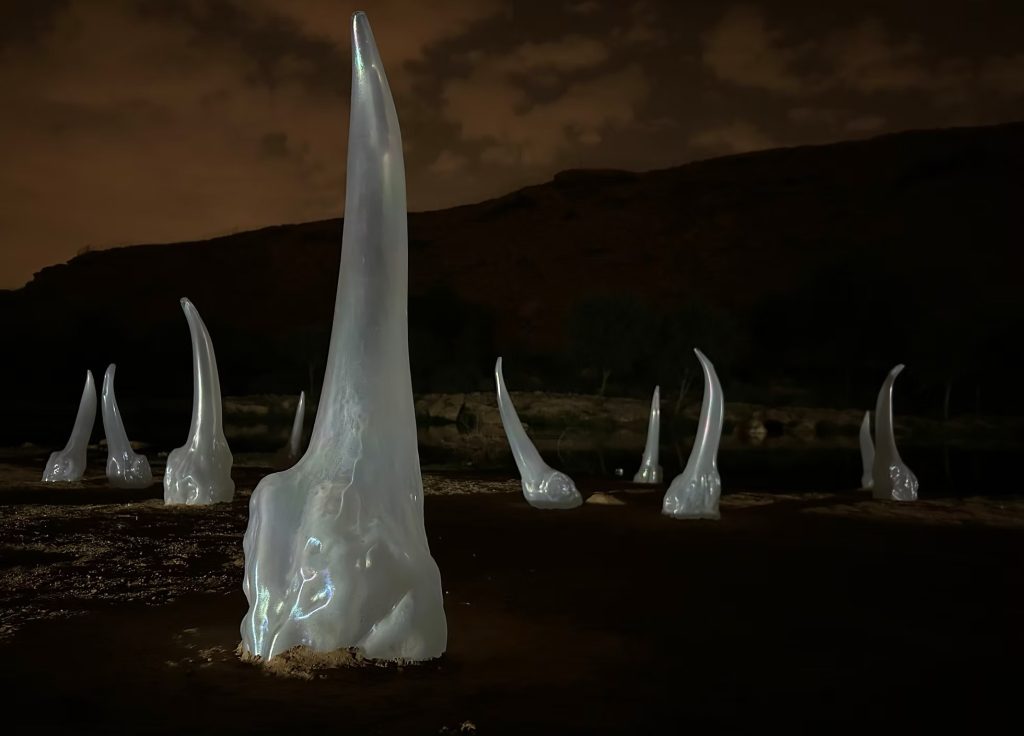
Dana Fiona Armour, Solenoglyphous C.C., 2023. Iridescent opaline, crystal glass, solar lights. Site-specific installation, 25 pieces (140 × 35 × 39 cm each, slightly variable). Installation view at Noor Riyadh Festival, Riyadh, Saudi Arabia, 2023. Curated by Jérôme Sans.
OO: A great example of this is your 2023 work Solenoglyphous C.C., inspired by the medical potential of snake venom. What were the most surprising discoveries from that research?
DFA: This project started during a residency at Villa Medici in Rome, where I studied the role of snakes in Greco-Roman medical history. Not everyone knows that snakes symbolize healing—Asclepius, the Greek god of medicine, cured people using them. It’s fascinating how venom can both kill and heal, depending on the dosage. Today, scientists are developing treatments for conditions like high blood pressure and even cancer using snake venom. What’s interesting is that once an animal becomes useful to humans, people start appreciating it. But my perspective is that all beings deserve respect, regardless of their usefulness. Our alienation from nature plays a role too—many people fear snakes simply because they never encounter them anymore.
OO: Coming from a small Norwegian town surrounded by nature, I feel disconnected from it here in Paris.
DFA: Absolutely. Even the forests in the outskirts of Paris are heavily controlled, which is a big issue. Habitat destruction is one reason for the decline of snake populations in France. There’s too much human intervention—forests are being cleared, and animals lose their space.
OO: Your Alvinella Ophis piece for the Sigg Art Prize also challenges viewers to reconsider their relationship with nature. How did you integrate this theme?
DFA: The piece imagines a future where humans are extinct due to climate change, and the last surviving creature is a hybrid between a Pompeii worm and a python. The Pompeii worm is the most heat-resistant animal on Earth, living in volcanic areas under the sea, while pythons have heat-sensing organs. In the exhibition, I installed heat sensors that tracked visitors, making the hybrid “see” them as prey—flipping the hunter-prey dynamic. The reactions were interesting; I realized that if I go too deep into the science, I lose people, so interactivity becomes key in making these ideas accessible.
OO: Just to clarify, you merged the properties of a Pompeii worm with a python’s heat-sensing organ?
DFA: Yes, exactly. I’ve even worked with genetic modification before, like my MC1R project, where I merged human DNA with a plant. Today, gene editing is entirely possible. Evolution takes time, but species adapt in ways we can’t predict. The Pompeii worm already has a symbiotic relationship with bacteria that protect it from heat, so imagining further hybridization isn’t so far-fetched.
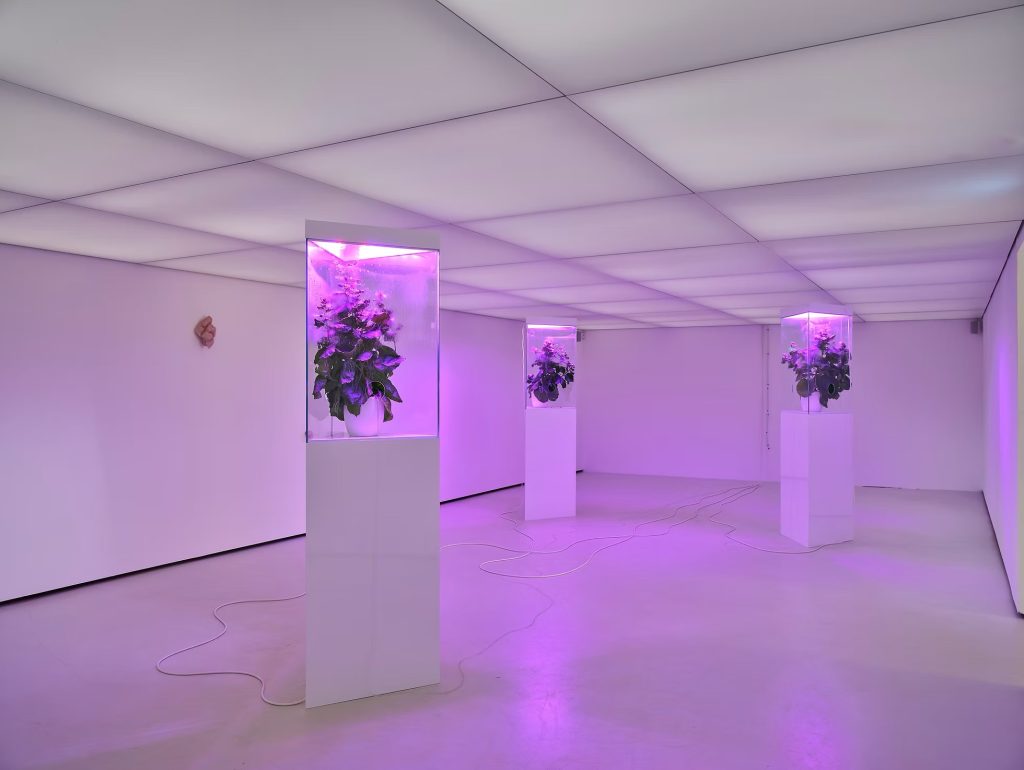
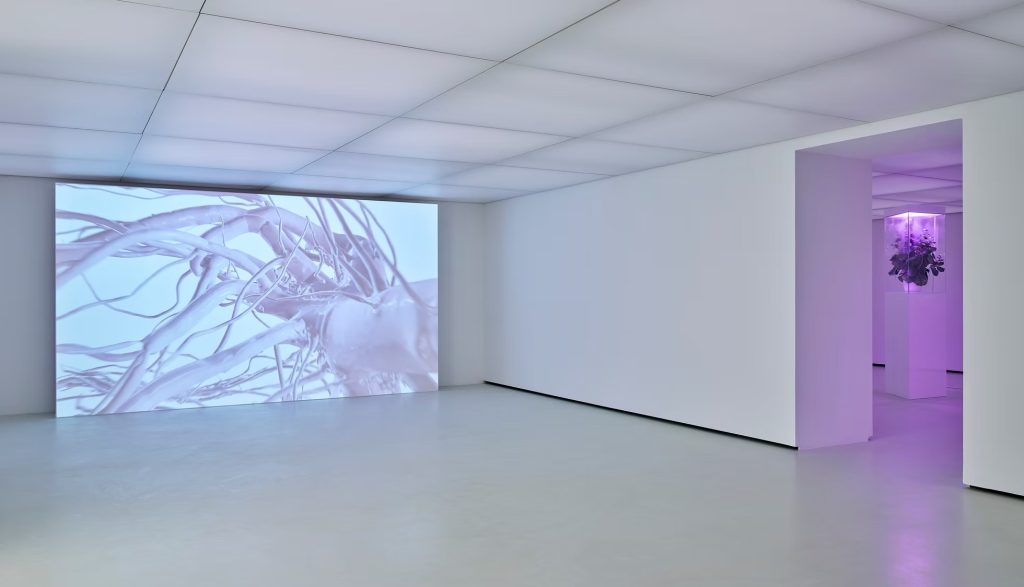
Dana Fiona Armour, Project MC1R, 2022. Nicotiana Benthamiana carrying the MC1R gene. Installation view at Collection Lambert, Avignon, France, 2022.
OO: You’re also very active at the Museum of Natural History in Paris. How does working with scientists influence your practice?
DFA: It’s endlessly inspiring. Being in this residency until the end of the year, I get to discuss ideas with researchers, which constantly fuels my work. In fact, I’m taking my students to the museum soon for a tour and to introduce our next project—an exhibition centered around ecology. One of the researchers I work with will guide them.
OO: That sounds like an amazing field trip! As an instructor at Parsons Paris, how do you approach teaching emerging artists?
DFA: Curiosity is the most important thing. AMT is all about the intersection of art and technology, so I encourage students to explore outside traditional research methods. Teaching is a huge responsibility, but it’s incredibly rewarding to see students grow from the first day of class to the final exhibition. Parsons Paris has very dedicated students, and the small class sizes allow for personal feedback, which I think is a great advantage.
OO: Your students’ upcoming exhibition Oneirophrenia explores dreamlike states. What themes have emerged so far?
DFA: I don’t want to reveal too much, but the title is quite open-ended. We gave them a prompt to create works inspired by dioramas—specifically, intimate or dreamlike spaces. Interestingly, most students moved away from literal apartments or bedrooms and leaned into surrealism. Their creativity is really impressive, and I think the show will have some surprises!
OO: Since graduating from Beaux-Arts in 2019, you’ve joined Poush Collective, gained gallery representation, and are now collaborating with the Museum of Natural History. What advice would you give students navigating residencies and galleries?
DFA: Get out there! You can work endlessly in your studio, but if no one sees your work, it stays there. Networking is crucial—meeting people helped me integrate into Poush and set up exhibitions. Art school can feel like a bubble, and once you graduate, reality hits. Joining a collective is a great way to stay connected and organize shows. Collaboration is key, especially early on. Keep pushing forward, even if it feels like nothing is happening—suddenly, the phone rings, and you have a show.
OO: I think many of us students assume a solo exhibition is the goal, but that’s hard when you’re just starting. Collaboration seems like a great strategy.
DFA: Exactly, collective energy is powerful.
OO: Any exciting upcoming projects you can share?
DFA: My residency at the Natural History Museum will culminate in a 2025 exhibition in Paris. I’m also working on a public art project in London on the same theme. The next Paris-based show will be a group exhibition at Poush’s Aubervilliers site on May 22, marking the collective’s final show there.
OO: Exciting! Thank you for this great conversation. I look forward to seeing your work and the AMT Sophomore exhibition at Galerie 45.
DFA: Thank you!
The AMT Sophomore exhibition Oneirophrenia: A Dreamlike State of Consciousness will have its vernissage on March 19 at 2 PM at Galerie 45. Come see the works developed in Core Studio and Lab Spatial, taught by Dana Fiona Armour and Francesca Bonesio. Hope to see you there!
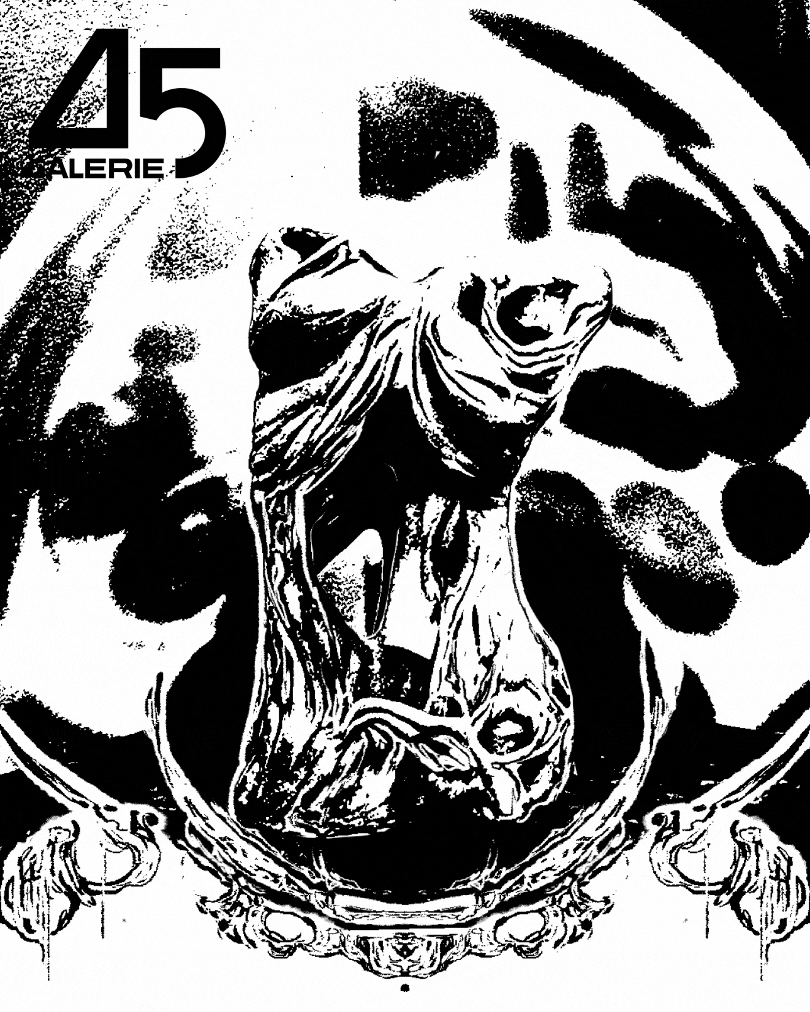
We acknowledge that some of the topics discussed in this interview, particularly those related to gene modifications, may raise ethical concerns. However, we want to emphasize that Dana-Fiona Amour’s work is not intended to harm any species. Her research and artistic practice are deeply rooted in a profound respect for nature, seeking to explore the intersection of science and art in a way that fosters understanding and dialogue.